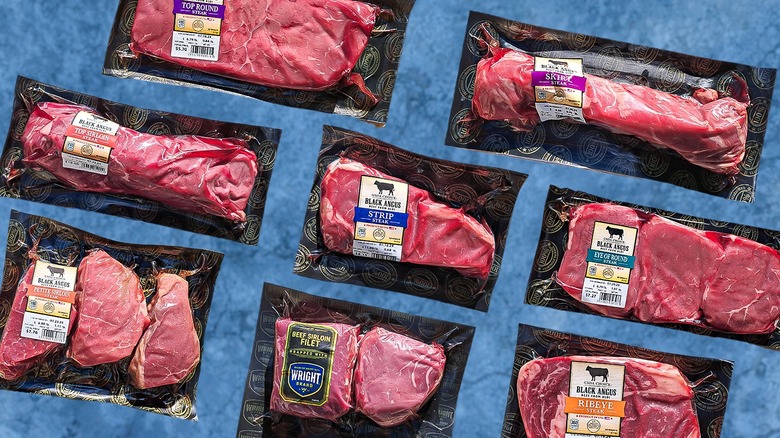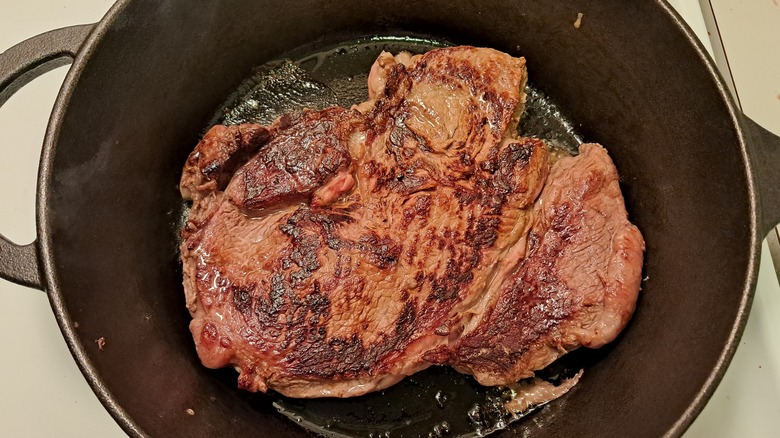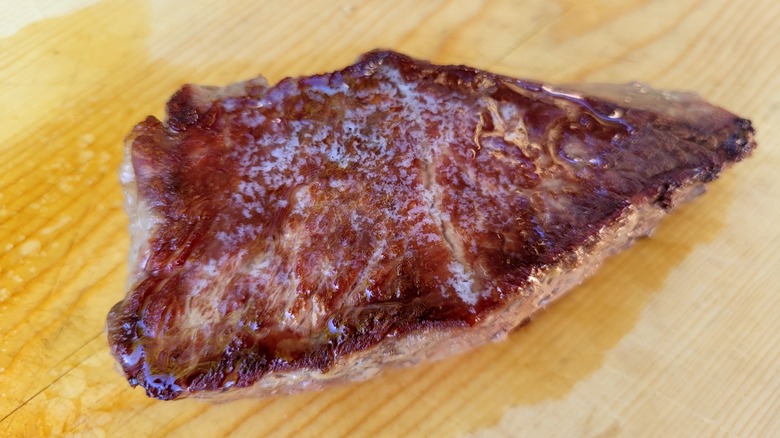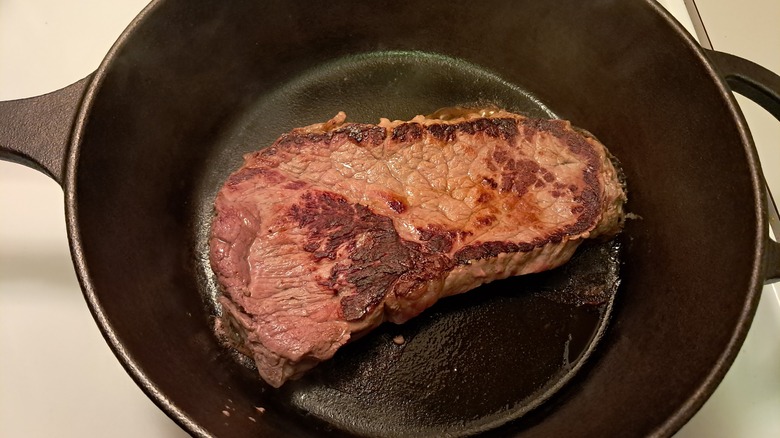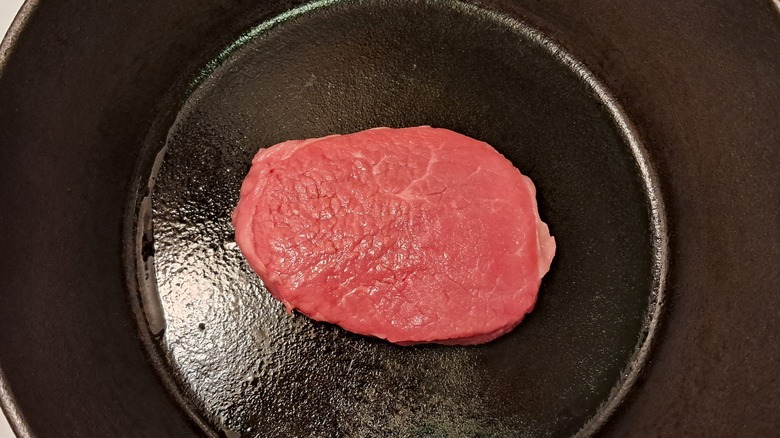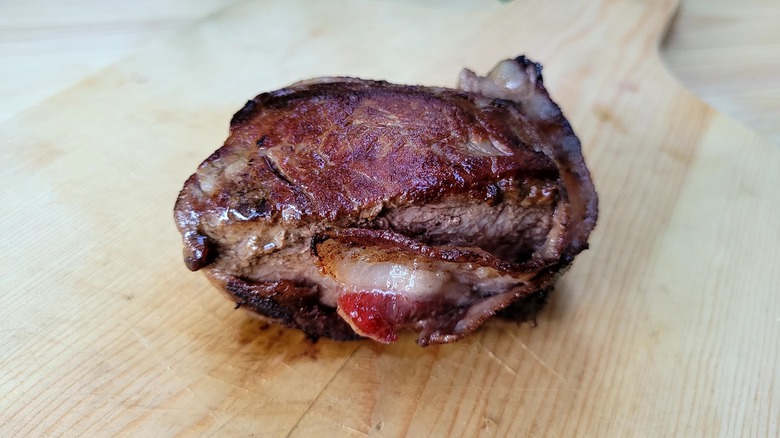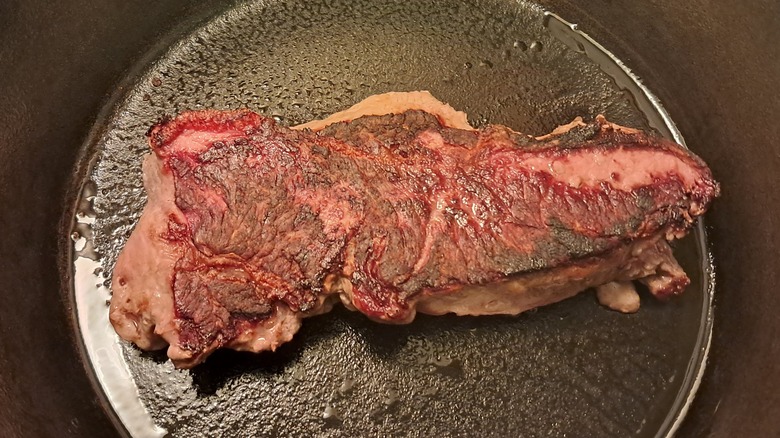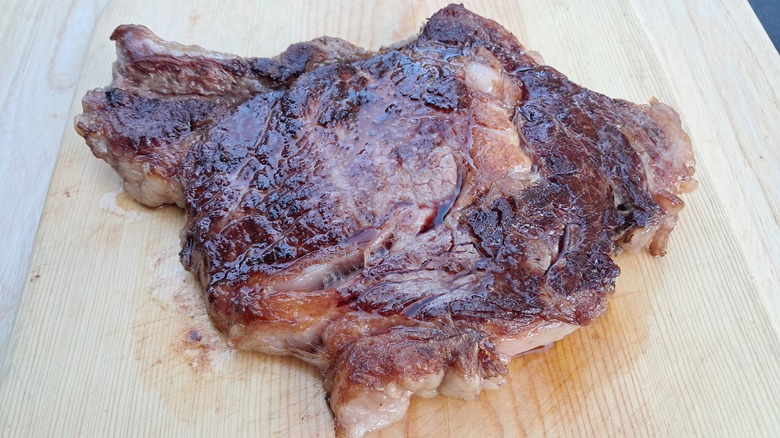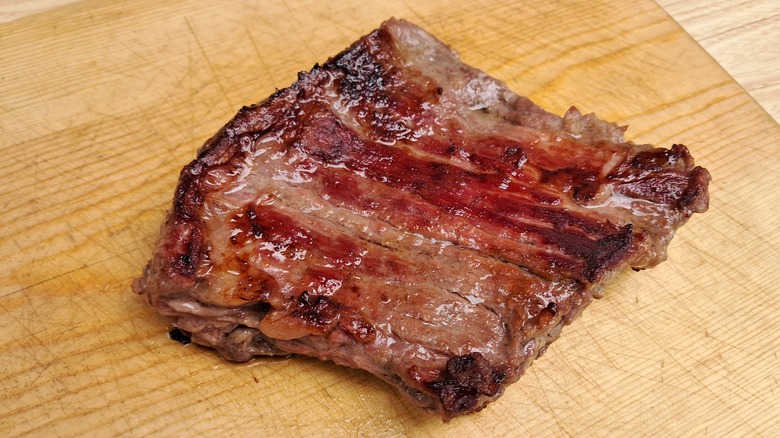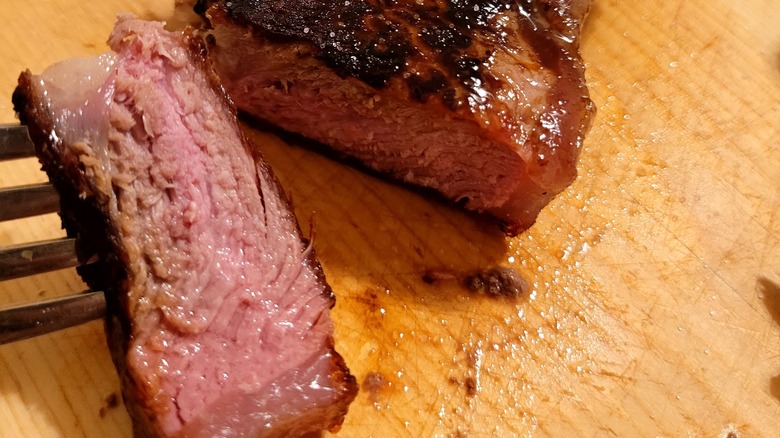Aldi Steaks Ranked From Worst To Best
You're in Aldi's meat section holding two vacuum packs of steak wondering which to buy. Every week, your family eats a steak dinner, complete with mashed potatoes and green salad. This event usually features the cheapest cut — top round or petite sirloin steak. Now, you're thinking a more expensive cut might be worth it. You want to know which is best before you swipe your card, though.
Aldi's meat section usually has around 10 types of steak. This article reviews the eight in stock the day I visited Aldi. At that time, most of the refrigerator contained the store brand, Black Angus. The products I purchased ranged from about $6.50 to $12 per pound, though those prices will depend on region and the time of year. Many of the packages at Aldi contain a single steak, but a few have two or three. Each cut has a distinctive taste and texture. Some are fattier and others are leaner. The thickest cuts take longer to prepare, while the thinnest only require a few minutes of searing on each side. If you want to know more about how I cooked the steaks for review, please read the methodology section of this article. However you prefer your steaks and whatever method you use for cooking them, you'll feel happiest if you buy the ones that reflect the taste, appetite, and prep time your family has. Read on to find the right fit for you and see which I liked best.
8. Top Round
If you're shopping for steak, top round is one item in the Aldi meat section that you'll want to skip. It's difficult to cook as steak and has an unattractive flavor profile — it just doesn't contain the same beefy deliciousness as other types of steak. Now, searing top round on a stovetop is a bit of a mistake. Ask around, and you'll find this cut usually goes in slow cooker recipes with chopped veggies and broth to make a stew or some other equally saucy dish. The slow cook time makes it tender and the other ingredients give it a better flavor.
For the sake of experimentation, though, I bought some top round and prepared it like the rest of the steaks in this article. After all, such a large, thick cut of meat looks tempting to eat on its own. I dabbed it with paper towels to remove the excess moisture and rubbed it with olive oil. Then I tried searing it in my cast-iron pan at medium. It was disastrous. The meat let out an amount of liquid that prevented the meat from forming a nice brown crust on the outside. That moisture also meant the meat became tougher than I would have liked. When I sat down to eat my steak, it was dry and grainy. This is not a cut I would ever buy again to make as steak.
7. Petite Sirloin
Aldi's Black Angus petite sirloin has an acceptable texture, but an unattractive metallic flavor, making it one of the lowest-ranked steaks in this article. This cut costs about $7 per pound and comes cut into small steaks. Each vacuum pack contains three and weighs around one pound. These look like perfect portion sizes for a family dinner and the price is alluring, but only adults will be able to handle the slightly unpleasant taste.
The small size means that they cook quickly — in about 12 minutes. They brown nicely in a cast-iron pan. Because of the way they taste, though, these are candidates for marinating overnight with strongly flavored herbs and spices. Plenty of garlic and mustard might do the trick. On the other hand, this recipe for a three-ingredient marinade with soy sauce, olive oil, and balsamic vinegar sounds delicious. The problem with this is it requires some forethought. One of the nicest things about good quality steak is you can usually throw it into your pan and fry it up deliciously in under 20 minutes. Buying petite sirloin and marinating it, on the other hand, means getting more dishes dirty and having to do some prep a day ahead of time. That partly negates the attractiveness of the low price.
6. Top Sirloin
Top sirloin steak from Aldi has wonderful flavor, but is tougher than some more expensive cuts. Then several characteristics of this steak make it difficult to prepare in a cast-iron pan. First, Aldi sells these steaks cut thick, but they are not fatty. In the pan, they tend to release a lot of liquid, so they'll quickly boil into an inedible brick if cooks aren't vigilant.
The top sirloin I bought weighed more than a pound and cost $10 (the per-pound price is around $7). It came rolled up in a vacuum pack. When I opened the package, it was larger than I expected. When I placed it in my pan, I had to watch it carefully, turning the heat up a notch above medium if I noticed it released too much moisture. I turned it back down once the liquid evaporated. The total cook time was about 14 minutes, resulting in a medium point. I enjoyed eating it, but it was too tough for my children to appreciate. I would love to make this cut at a low temperature on the grill where the moisture would drip down or evaporate more easily. It would get a nice smoky flavor. Finally, it's cheap enough to serve at a barbecue with friends where you don't want to spend too much money.
5. Eye of Round
Eye of round from Aldi is for you if you're looking for a cheaper priced lean steak that tastes great and you don't mind a tougher texture. An additional positive feature of these steaks is their small size and the package of three or four. That makes them family-friendly. As long as you have sides like cooked veggies and mashed potatoes, you can prepare a hearty meal for your family of four featuring these steaks without having to spend more than $11 — $7 for the meat, $1 for frozen veggies, and about $3 for a bag of potatoes. These steaks would also make great hot sandwiches on toasted bread with gravy.
My vacuum pack came with three small steaks and weighed just over a pound. The only problem I had when preparing them was the center part of the steak popped up from the pan while it was cooking, making it convex. The edges browned and crisped, but the center didn't. When I flipped the meat, only the center touched the hot surface and I had to use tongs to hold it down and ensure even cooking. In about 12 minutes at medium, these steaks were well-done to a point that seemed safe for feeding my littles. If I hadn't prepared this steak in a cast-iron skillet to better compare it to other cuts, I would likely have slow-cooked it with sauce and veggies in my Dutch oven for a more tender texture.
4. Bacon-wrapped Filet
The soft, buttery texture and fantastic taste of the Wright Brand bacon-wrapped beef sirloin steak from Aldi made it stand out. Sadly, the flat flavor of the bacon didn't match up to the quality of the beef. Additionally, this product is misleading since it is not filet mignon, but rather a boneless sirloin cut. A filet can come from any part of an animal while filet mignon is only the tip of the tenderloin. Naïve customers might think, "Wow! A great deal — $9 a pound for filet mignon! That's usually the most expensive cut." Really, they would be buying an inferior product without knowing it.
Then, there's good reason to be careful when cooking this meat — it likely went through mechanical tenderization. That's a process in which machines use tiny needles to punch holes in meat, imparting sublime, buttery texture. Unfortunately, the spindles can carry harmful bacteria from the surface to the interior. So thorough cooking is vital — the center must reach at least 145 degrees Fahrenheit and stay there for three minutes. Considering the thickness, that's not an easy feat. The cook time for my filet was nearly 20 minutes, the longest in this article. Yet the interior still had a medium-rare color and texture, and the exterior was worryingly dark. I didn't measure the temperature, but doubt that I complied with the formerly stated instructions from the package — I worried that cooking it any longer would result in tough, dry meat.
3. Strip
Strip steak from Aldi tastes deliciously beefy, not fatty or metallic, but it is a bit tricky to cook, and at around $12 per pound, it's more expensive than other cuts. This type of steak comes in a long, thick piece. The depth of this cut gives it a longer stovetop cook time. Some cooks might prefer searing it just long enough to form a crust on each side of the steak and then finish the dish in the oven. That method keeps the center moist and tender. Taking the extra step makes sense because preparing strip steak incorrectly can result in dry, tough meat. That would be a shame, since correctly cooked strip steak is mind-blowingly delicious.
The strip steak I prepared only in a cast-iron pan on the stovetop (for the sake of comparison) weighed just over ⅔ of a pound — a perfect serving size for a dinner party. It was one of the smallest steaks on the shelf, though. Each of these came individually vacuum-packed, making it straightforward to buy exactly the number you need. When I put my steak in the pan to sear, it released more grease than moisture and formed a brown crust on the top and bottom. After 16 minutes, it was medium well-done and had remained mostly tender. If you have the time, patience, and budget to serve this steak, it's a cut that's sure to impress at a dinner party or holiday family gathering.
2. Rib eye
Aldi's Black Angus brand rib eye is enticing with its beautiful marbling of fat throughout and great taste, but unfortunately, this cut has a big price tag. The crust that forms on the outer part of this steak is its most alluring characteristic. Fat from the meat melts and helps sear a crispy exterior layer while the interior remains tender. The meat grain is looser than in other cuts, making it softer and easier for kids to chew. The amount of grease can be overwhelming, though. My rib eye released so much, that I had to mop it up with paper towels and it left a tallowy sensation in my mouth. A glass of red wine quickly easily washes that away, though.
This rib eye comes cut in nice thick portions and each vacuum pack contains a single, approximately one-pound steak. The massive size results in longer cook time — 16 minutes at medium gave me a steak with a crispy crust on the outside and medium rare meat inside. Next time, I plan on searing it for about two minutes longer. Then, there's the price. Calculate about $12 per head if buying one steak per person. That's an abundant portion, though. So you could buy less and cut each steak in half, though the final plating would look less dramatic. However you decide to divvy up the meat, Aldi's rib eye is scrumptious and well worth the price tag, even if that limits you to only eating it on special occasions.
1. Skirt
The Black Agus skirt steak from Aldi has fantastic flavor, a tender texture, and is easy to make. It tastes like beef without having a tallowy profile and the grain of the meat is loose, not dense. The cut is thin enough and contains sufficient fat to form a crust when seared , but without leaving the center dry and tough. Even inexperienced cooks will be able to prep this steak without breaking a sweat.
Each Aldi skirt steak comes rolled into a long log and vacuum-packed, which makes it look like a thicker cut than it is. When you take it out and spread it, you'll see that it's much thinner than expected and a bit bumpy — not as clean-cut as many other types of steak. That makes it less visually pleasing, but the taste makes up for it. When I opened the skirt steak I had purchased, it was too big to fit in my cast-iron pan even though it only weighed ¾ of a pound. I cut it in half so it wouldn't be crowded while cooking and then seared it for about 10 minutes and got a perfect, medium-point steak.
At $9.49 per pound, it falls in the middle of the price range. It's more accessible than the priciest steaks, but higher in price than the cheapest by about 40%. Depending on your budget, this could easily be the weekly highlight of your household menu without breaking the bank.
Methodology
I prepared all eight steaks in the same way to rank them as fairly as possible. First, I left them out for around 45 minutes before cooking so they'd be at room temperature. I patted them with paper towels to remove excess liquid and rubbed on about ½ tablespoon of olive oil. Then I set the stove to medium and put a cast-iron pan on to get nice and hot. As soon as the meat made contact, it sizzled. The intensity of this sound was one of the measures I used to judge if I needed more or less heat. I cooked the steaks one at a time. I seared them on the first side without moving them until I saw beads of liquid evenly dotting the top. That's when I flipped the steak. Then I left them searing until the opposite side also became beautifully brown and crusty and the meat was cooked through. Times for the steaks varied since this depended the thickness of the cuts. If I thought a steak might take longer, I turned the burner down one point on the burner's temperature knob. If the steak released too much liquid to sear properly, I quickly soaked up the liquid with paper towels and turned the burner up one temperature point. Salt was the only seasoning I used, and I sprinkled it on after removing the steak from the burner.
Using this method highlighted certain characteristics of the steaks. For example, fattier steaks formed lovelier crusts, while leaner ones just browned. Two types of steak didn't brown evenly because they wouldn't lie flat in the pan — they warped when heated and parts popped up. Finally, the density and taste of the meat became evident. I took notes about the cook time, taste, texture, and point of each steak. I also factored in the price-quality relationship when it came time to rank them.
